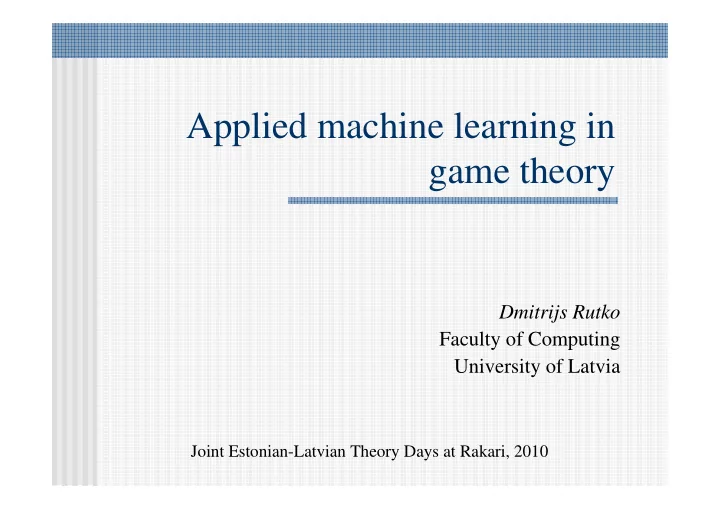

Applied machine learning in game theory Dmitrijs Rutko Faculty of Computing University of Latvia Joint Estonian-Latvian Theory Days at Rakari, 2010
Topic outline � Game theory � Game Tree Search � Fuzzy approach � Machine learning � Heuristics � Neural networks � Adaptive / Reinforcement learning � Card games
Research overview � Deterministic / stochastic games � Perfect / imperfect information games
Finite zero-sum games deterministic chance perfect information chess, checkers, go, backgammon, othello monopoly, roulette imperfect battleship, bridge, poker, information kriegspiel, rock- scrabble paper-scissors
Topic outline � Game theory � Game Tree Search � Fuzzy approach � Machine learning � Heuristics � Neural networks � Adaptive / Reinforcement learning � Card games
Game trees
Classical algorithms max � MiniMax 8 � O(w d ) min � Alpha-Beta 2 8 � O(w d/2 ) max 2 7 8 9 1 2 7 4 3 6 8 9 5 4 √ √ √ Χ Χ √ √ √ Χ Χ
Advanced search techniques � Transposition tables � Time efficiency / high cost of space � PVS � Negascout � NegaC* � SSS* / DUAL* � MTD(f)
Fuzzy approach max � O(w d/2 ) ≥ 5 � More cut-offs min <5 ≥ 5 max <5 ? ≥ 5 ≥ 5 1 2 7 4 3 6 8 9 5 4 √ √ Χ Χ Χ √ Χ √ Χ Χ
Geometric interpretation � 1) X 2 - successful separation � 2) X 1 or X 3 - reduced search window α β 2 8 X 1 X 3 α = X 1 β = X 3 X 2
BNS enhancement through self- training � Traditional statistical approach Minimax Tree value count 25 1 26 5 27 11 28 38 29 124 30 206 31 252 32 189 33 111 34 42 35 14 36 7 1000
Two dimensional game sub-tree distribution Tree 23 24 25 26 27 28 29 30 31 32 33 34 35 36 count 23 0 0 24 0 0 0 25 0 1 0 1 26 0 0 2 3 5 27 0 0 5 3 3 11 28 0 1 0 12 12 13 38 29 0 0 2 10 35 43 34 124 30 1 2 6 9 26 58 71 33 206 31 0 0 6 10 27 41 78 57 33 252 32 0 1 3 13 17 30 32 41 38 14 189 33 0 0 1 2 8 12 26 28 21 11 2 111 34 0 0 0 1 3 5 13 8 6 2 2 2 42 35 0 0 0 0 0 2 4 3 2 3 0 0 0 14 36 0 0 0 0 0 0 1 2 2 1 1 0 0 0 7
Statistical sub-tree separation Separation Tree value count 23 0 24 1 25 6 26 30 27 88 28 208 29 374 30 509 31 475 32 325 33 167 34 61 35 21 36 7 2272
Experimental results. 2-width trees
Experimental results. 3-width trees
Future research directions in game tree search � Multi-dimensional self-training � Wider trees � Real domain games
Topic outline � Game theory � Game Tree Search � Fuzzy approach � Machine learning � Heuristics � Neural networks � Adaptive / Reinforcement learning � Card games
Games with element of chance
Expectiminimax algorithm � Expectiminimax(n) = � Utility(n) • If n is a terminal state � Max s ∈ Successors(n) Expectiminimax(s) • if n is a max node � Min s ∈ Successors(n) Expectiminimax(s) • if n is a min node � Σ s ∈ Successors(n) P(s) * Expectiminimax(s) • if n is a chance node � O(w d c d )
Perfomance in Backgammon *-Minimax Performance in Backgammon, Thomas Hauk, Michael Buro, and Jonathan Schaeer
Backgammon � Evaluation methods � Static – pip count � Heuristic – key points � Neural Networks
Temporal difference (TD) learning � Reinforcement learning � Prediction method
Experimental setup � Multi-layer perceptron � Representation encoding � Raw data (27 inputs) � Unary (157 inputs) � Extended unary (201 inputs) � Binary (201 input) � Training game series – 400 000 games
Learning results
Program “DM Backgammon”
Topic outline � Game theory � Game Tree Search � Fuzzy approach � Machine learning � Heuristics � Neural networks � Adaptive / Reinforcement learning � Card games
Artificial Intelligence and Poker* AI Problems Poker problems Imperfect information Hidden cards Multiple agents Multiple human players Risk management Bet strategy and outcome Agent modeling Opponent(s) modeling Misleading information Bluffing Unreliable information Taking bluffing into account * Joint work with Annija Rupeneite
Questions ? dim_rut@inbox.lv
Recommend
More recommend